Solaris Resources (TSX: SLS) has doubled the drill campaign, from six rigs to 12, following a significant new discovery at its Warintza copper project in Ecuador’s main mining district in the southeast, as geophysics revealed a much more extensive porphyry system than previously anticipated.
“It's a much larger, more extensive system than surface geochemistry and mapping implied,” said Solaris CEO, Daniel Earle. The latest discovery highlights a laterally extensive mineralized system, building on the resource and recent drilling at Warintza Central where Solaris has successfully drilled high-grade copper mineralization up to 1% copper-equivalent and up to 1 km in depth starting from surface. “It's larger than the CN tower at 553 metres – over a kilometre of high-grade copper mineralization, like two CN towers stacked on top of each other.”
[caption id="attachment_1003745759" align="aligncenter" width="550"]
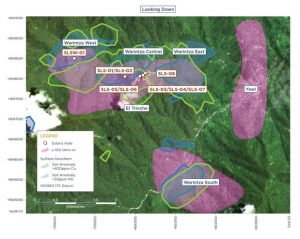 Warintza targets. Credit: Solaris Resources
Warintza targets. Credit: Solaris Resources[/caption]
The geophysical data indicated the presence of a considerably more extensive porphyry system than had previously been outlined, with the potential for the Central, West, East and El Trinche targets to form a continuous 3.5km long x 1km wide x 1km deep mineralized body. The deeper anomalies at Warintza South and the previously unidentified Yawi target were also significantly larger in size than the surface geochemical expression would have suggested.
[caption id="attachment_1003745761" align="aligncenter" width="550"]
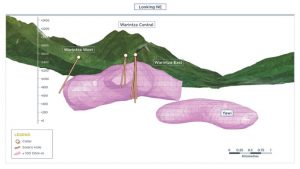 Warintza cross-section. Credit: Solaris Resources
Warintza cross-section. Credit: Solaris Resources[/caption]
These results continue to suggest Solaris is on the margins of a potentially substantial mineralized system.
The Warintza project is situated in proximity to major infrastructure needed to develop a mining project of this scale. With road access completed in 2020, Warintza is connected to Highway 45, the central highway grid in Ecuador that runs north south to the well- endowed mineral belt where Fruta del Norte and Mirador mines are located, 40 kilometres to the south, hosting billions of tonnes of copper, and millions of ounces of high-grade gold.
[caption id="attachment_1003745762" align="aligncenter" width="550"]
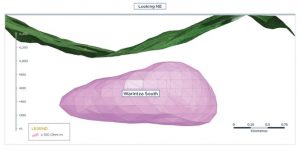 Warintza South section. Credit: Solaris Resources
Warintza South section. Credit: Solaris Resources[/caption]
Along with a supply of abundant fresh water, Warintza’s grid is supplied with clean, low-cost electric power and the ability to get supplies in and out. All of the infrastructure is in place -- a primary driver of capital costs for large scale projects.
Andean mining jurisdictions in Chile and Peru have been heavily explored over the decades since David Lowell co-defined the porphyry copper model in the early 1960s, but Ecuador is very much a new frontier. The country had a false start in the early 2000s when Lowell discovered Warintza and Mirador (and Fruta del Norte was discovered by Steve Leahy of Aurelian) but the sociopolitical conditions did not support these projects being developed. Warintza had the additional obstacle of a lack of social license due to a dispute over surface rights with the Traditional Owners which stalled the project post-discovery.
Solaris Resources, through an innovative community social relations (CSR) program, central to the company’s overall ESG framework, was able to successfully resolve the socio-political risks.
The project resides on the Ancestral Lands of the Shuar Nations of Warints and Yawi, and these Nations have constitutionally protected rights to self-determination on their territories free from interference from outside groups.
“Through consultation, we were able to get to the bottom of what precipitated the breakdown in social license in the early 2000s, Earle explained. “We were able to resolve that issue and enter into an agreement for the restart of exploration on the project, which was a memorandum of understanding (MOU), signed in 2019.”
Since the MOU, Solaris and the Shuar Nations completed an Impacts and Benefits Agreement (IBA) in 2020 which governs the relationship between a resource developer and the Traditional Owners of the lands.
“While an IBA represents industry best practice in other jurisdictions, it is the first time one has been completed in Ecuador, and it provides certainty of community support for this project from the exploration stage, which was covered under the MOU, all the way through to the development stage, construction, into production, and eventually to the closure of the project,” Earle said.
[caption id="attachment_1003745789" align="aligncenter" width="550"]
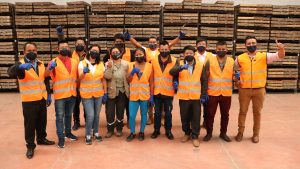 Warintza core shack. Credit: Solaris Resources
Warintza core shack. Credit: Solaris Resources[/caption]
“As a result, we have a concrete social license with these communities. These are the strongest proponents of the project that we could have.”
The riches of Peru, Chile and Argentina have long been unlocked, and Ecuador is like the last link in the chain -- and is now seeing major copper discoveries like Solgold’s massive Cascabel project.
Earle said Cascabel is one of the best discoveries in at least the last decade of global copper exploration and that it occurred in Ecuador is not surprising given the incredible mineral endowment and lack of serious exploration.
The local population is 500 people between the two Shuar Nations. Of 230 Solaris employees at the site, 184 are from those Shuar communities.
“Everyone who wants a job within these communities has a job -- and we’re trying to increase capacity through the skills, health and safety training programs we have, and go beyond that with the business kickstarter programs we have in place,” Earle said.
Through community development work and a partnership with the City of Limon, road access improves logistics for the project and also for the communities, providing opportunities beyond the scope of the project.
[caption id="attachment_1003745763" align="aligncenter" width="550"]

Drillers at Warintza. Credit: Solaris Resources[/caption]
“Community work is at the core of our company -- it's why we’re here. The very genesis of this project was restoring its social license,” Earle said. “And it goes beyond the boundaries of the project itself, beyond our IBA – extending benefits and cooperation outward from our core project and host communities to have positive impacts in neighboring communities, and developing partnerships with these communities and institutions at all levels of government extend the reach of our program and add layers of relationships to provide further support to the social license for the project.”
At the height of the pandemic, while transitioning from exploration and ramp up activities -- humanitarian activities provided fuel, food and medical supplies to partners and local communities in a joint project between Solaris with the Ecuador military and the Ministry of Health.
“This is how the mining industry has a positive impact in the exploration stage,” Earle said. “Through employment, through education, skills and safety training, and through infrastructure and community development. And this is an area in Ecuador that desperately needs it.”
The preceding Joint-Venture Article is PROMOTED CONTENT sponsored by Solaris Resources, and produced in cooperation with www.CanadianMiningJournal.com. Visit https://www.solarisresources.com/ for more information.
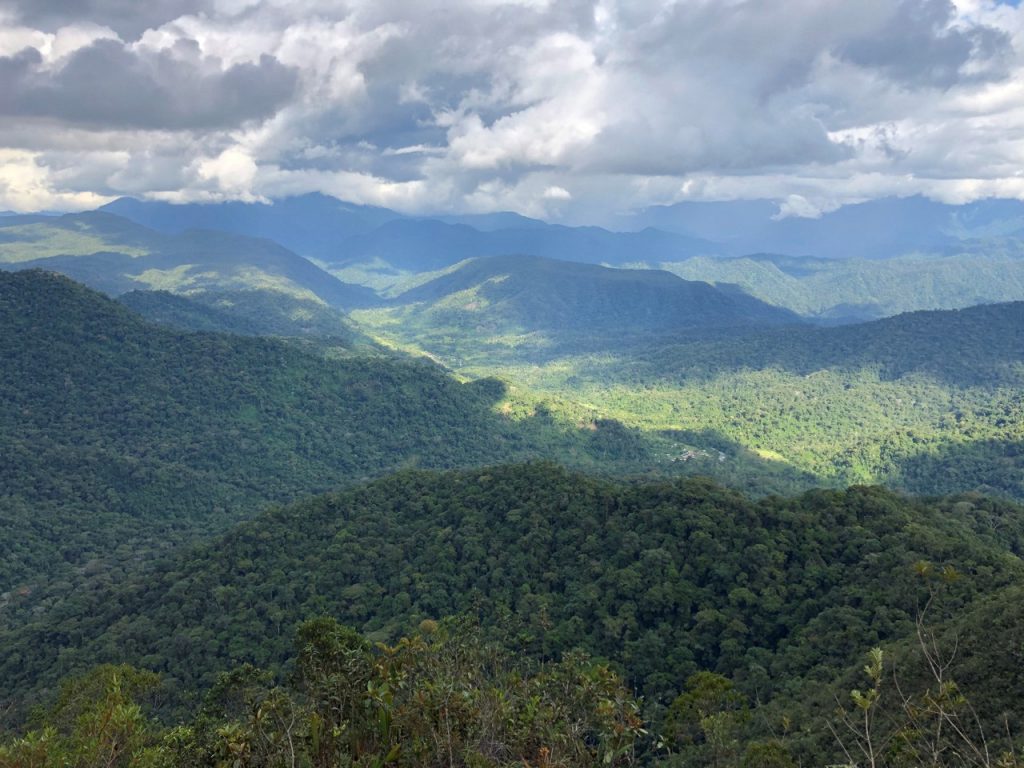
 Warintza targets. Credit: Solaris Resources[/caption]
The geophysical data indicated the presence of a considerably more extensive porphyry system than had previously been outlined, with the potential for the Central, West, East and El Trinche targets to form a continuous 3.5km long x 1km wide x 1km deep mineralized body. The deeper anomalies at Warintza South and the previously unidentified Yawi target were also significantly larger in size than the surface geochemical expression would have suggested.
[caption id="attachment_1003745761" align="aligncenter" width="550"]
Warintza targets. Credit: Solaris Resources[/caption]
The geophysical data indicated the presence of a considerably more extensive porphyry system than had previously been outlined, with the potential for the Central, West, East and El Trinche targets to form a continuous 3.5km long x 1km wide x 1km deep mineralized body. The deeper anomalies at Warintza South and the previously unidentified Yawi target were also significantly larger in size than the surface geochemical expression would have suggested.
[caption id="attachment_1003745761" align="aligncenter" width="550"] Warintza cross-section. Credit: Solaris Resources[/caption]
These results continue to suggest Solaris is on the margins of a potentially substantial mineralized system.
The Warintza project is situated in proximity to major infrastructure needed to develop a mining project of this scale. With road access completed in 2020, Warintza is connected to Highway 45, the central highway grid in Ecuador that runs north south to the well- endowed mineral belt where Fruta del Norte and Mirador mines are located, 40 kilometres to the south, hosting billions of tonnes of copper, and millions of ounces of high-grade gold.
[caption id="attachment_1003745762" align="aligncenter" width="550"]
Warintza cross-section. Credit: Solaris Resources[/caption]
These results continue to suggest Solaris is on the margins of a potentially substantial mineralized system.
The Warintza project is situated in proximity to major infrastructure needed to develop a mining project of this scale. With road access completed in 2020, Warintza is connected to Highway 45, the central highway grid in Ecuador that runs north south to the well- endowed mineral belt where Fruta del Norte and Mirador mines are located, 40 kilometres to the south, hosting billions of tonnes of copper, and millions of ounces of high-grade gold.
[caption id="attachment_1003745762" align="aligncenter" width="550"] Warintza South section. Credit: Solaris Resources[/caption]
Along with a supply of abundant fresh water, Warintza’s grid is supplied with clean, low-cost electric power and the ability to get supplies in and out. All of the infrastructure is in place -- a primary driver of capital costs for large scale projects.
Andean mining jurisdictions in Chile and Peru have been heavily explored over the decades since David Lowell co-defined the porphyry copper model in the early 1960s, but Ecuador is very much a new frontier. The country had a false start in the early 2000s when Lowell discovered Warintza and Mirador (and Fruta del Norte was discovered by Steve Leahy of Aurelian) but the sociopolitical conditions did not support these projects being developed. Warintza had the additional obstacle of a lack of social license due to a dispute over surface rights with the Traditional Owners which stalled the project post-discovery.
Solaris Resources, through an innovative community social relations (CSR) program, central to the company’s overall ESG framework, was able to successfully resolve the socio-political risks.
The project resides on the Ancestral Lands of the Shuar Nations of Warints and Yawi, and these Nations have constitutionally protected rights to self-determination on their territories free from interference from outside groups.
“Through consultation, we were able to get to the bottom of what precipitated the breakdown in social license in the early 2000s, Earle explained. “We were able to resolve that issue and enter into an agreement for the restart of exploration on the project, which was a memorandum of understanding (MOU), signed in 2019.”
Since the MOU, Solaris and the Shuar Nations completed an Impacts and Benefits Agreement (IBA) in 2020 which governs the relationship between a resource developer and the Traditional Owners of the lands.
“While an IBA represents industry best practice in other jurisdictions, it is the first time one has been completed in Ecuador, and it provides certainty of community support for this project from the exploration stage, which was covered under the MOU, all the way through to the development stage, construction, into production, and eventually to the closure of the project,” Earle said.
[caption id="attachment_1003745789" align="aligncenter" width="550"]
Warintza South section. Credit: Solaris Resources[/caption]
Along with a supply of abundant fresh water, Warintza’s grid is supplied with clean, low-cost electric power and the ability to get supplies in and out. All of the infrastructure is in place -- a primary driver of capital costs for large scale projects.
Andean mining jurisdictions in Chile and Peru have been heavily explored over the decades since David Lowell co-defined the porphyry copper model in the early 1960s, but Ecuador is very much a new frontier. The country had a false start in the early 2000s when Lowell discovered Warintza and Mirador (and Fruta del Norte was discovered by Steve Leahy of Aurelian) but the sociopolitical conditions did not support these projects being developed. Warintza had the additional obstacle of a lack of social license due to a dispute over surface rights with the Traditional Owners which stalled the project post-discovery.
Solaris Resources, through an innovative community social relations (CSR) program, central to the company’s overall ESG framework, was able to successfully resolve the socio-political risks.
The project resides on the Ancestral Lands of the Shuar Nations of Warints and Yawi, and these Nations have constitutionally protected rights to self-determination on their territories free from interference from outside groups.
“Through consultation, we were able to get to the bottom of what precipitated the breakdown in social license in the early 2000s, Earle explained. “We were able to resolve that issue and enter into an agreement for the restart of exploration on the project, which was a memorandum of understanding (MOU), signed in 2019.”
Since the MOU, Solaris and the Shuar Nations completed an Impacts and Benefits Agreement (IBA) in 2020 which governs the relationship between a resource developer and the Traditional Owners of the lands.
“While an IBA represents industry best practice in other jurisdictions, it is the first time one has been completed in Ecuador, and it provides certainty of community support for this project from the exploration stage, which was covered under the MOU, all the way through to the development stage, construction, into production, and eventually to the closure of the project,” Earle said.
[caption id="attachment_1003745789" align="aligncenter" width="550"] Warintza core shack. Credit: Solaris Resources[/caption]
“As a result, we have a concrete social license with these communities. These are the strongest proponents of the project that we could have.”
The riches of Peru, Chile and Argentina have long been unlocked, and Ecuador is like the last link in the chain -- and is now seeing major copper discoveries like Solgold’s massive Cascabel project.
Earle said Cascabel is one of the best discoveries in at least the last decade of global copper exploration and that it occurred in Ecuador is not surprising given the incredible mineral endowment and lack of serious exploration.
The local population is 500 people between the two Shuar Nations. Of 230 Solaris employees at the site, 184 are from those Shuar communities.
“Everyone who wants a job within these communities has a job -- and we’re trying to increase capacity through the skills, health and safety training programs we have, and go beyond that with the business kickstarter programs we have in place,” Earle said.
Through community development work and a partnership with the City of Limon, road access improves logistics for the project and also for the communities, providing opportunities beyond the scope of the project.
[caption id="attachment_1003745763" align="aligncenter" width="550"]
Warintza core shack. Credit: Solaris Resources[/caption]
“As a result, we have a concrete social license with these communities. These are the strongest proponents of the project that we could have.”
The riches of Peru, Chile and Argentina have long been unlocked, and Ecuador is like the last link in the chain -- and is now seeing major copper discoveries like Solgold’s massive Cascabel project.
Earle said Cascabel is one of the best discoveries in at least the last decade of global copper exploration and that it occurred in Ecuador is not surprising given the incredible mineral endowment and lack of serious exploration.
The local population is 500 people between the two Shuar Nations. Of 230 Solaris employees at the site, 184 are from those Shuar communities.
“Everyone who wants a job within these communities has a job -- and we’re trying to increase capacity through the skills, health and safety training programs we have, and go beyond that with the business kickstarter programs we have in place,” Earle said.
Through community development work and a partnership with the City of Limon, road access improves logistics for the project and also for the communities, providing opportunities beyond the scope of the project.
[caption id="attachment_1003745763" align="aligncenter" width="550"] Drillers at Warintza. Credit: Solaris Resources[/caption]
“Community work is at the core of our company -- it's why we’re here. The very genesis of this project was restoring its social license,” Earle said. “And it goes beyond the boundaries of the project itself, beyond our IBA – extending benefits and cooperation outward from our core project and host communities to have positive impacts in neighboring communities, and developing partnerships with these communities and institutions at all levels of government extend the reach of our program and add layers of relationships to provide further support to the social license for the project.”
At the height of the pandemic, while transitioning from exploration and ramp up activities -- humanitarian activities provided fuel, food and medical supplies to partners and local communities in a joint project between Solaris with the Ecuador military and the Ministry of Health.
“This is how the mining industry has a positive impact in the exploration stage,” Earle said. “Through employment, through education, skills and safety training, and through infrastructure and community development. And this is an area in Ecuador that desperately needs it.”
The preceding Joint-Venture Article is PROMOTED CONTENT sponsored by Solaris Resources, and produced in cooperation with
Drillers at Warintza. Credit: Solaris Resources[/caption]
“Community work is at the core of our company -- it's why we’re here. The very genesis of this project was restoring its social license,” Earle said. “And it goes beyond the boundaries of the project itself, beyond our IBA – extending benefits and cooperation outward from our core project and host communities to have positive impacts in neighboring communities, and developing partnerships with these communities and institutions at all levels of government extend the reach of our program and add layers of relationships to provide further support to the social license for the project.”
At the height of the pandemic, while transitioning from exploration and ramp up activities -- humanitarian activities provided fuel, food and medical supplies to partners and local communities in a joint project between Solaris with the Ecuador military and the Ministry of Health.
“This is how the mining industry has a positive impact in the exploration stage,” Earle said. “Through employment, through education, skills and safety training, and through infrastructure and community development. And this is an area in Ecuador that desperately needs it.”
The preceding Joint-Venture Article is PROMOTED CONTENT sponsored by Solaris Resources, and produced in cooperation with 

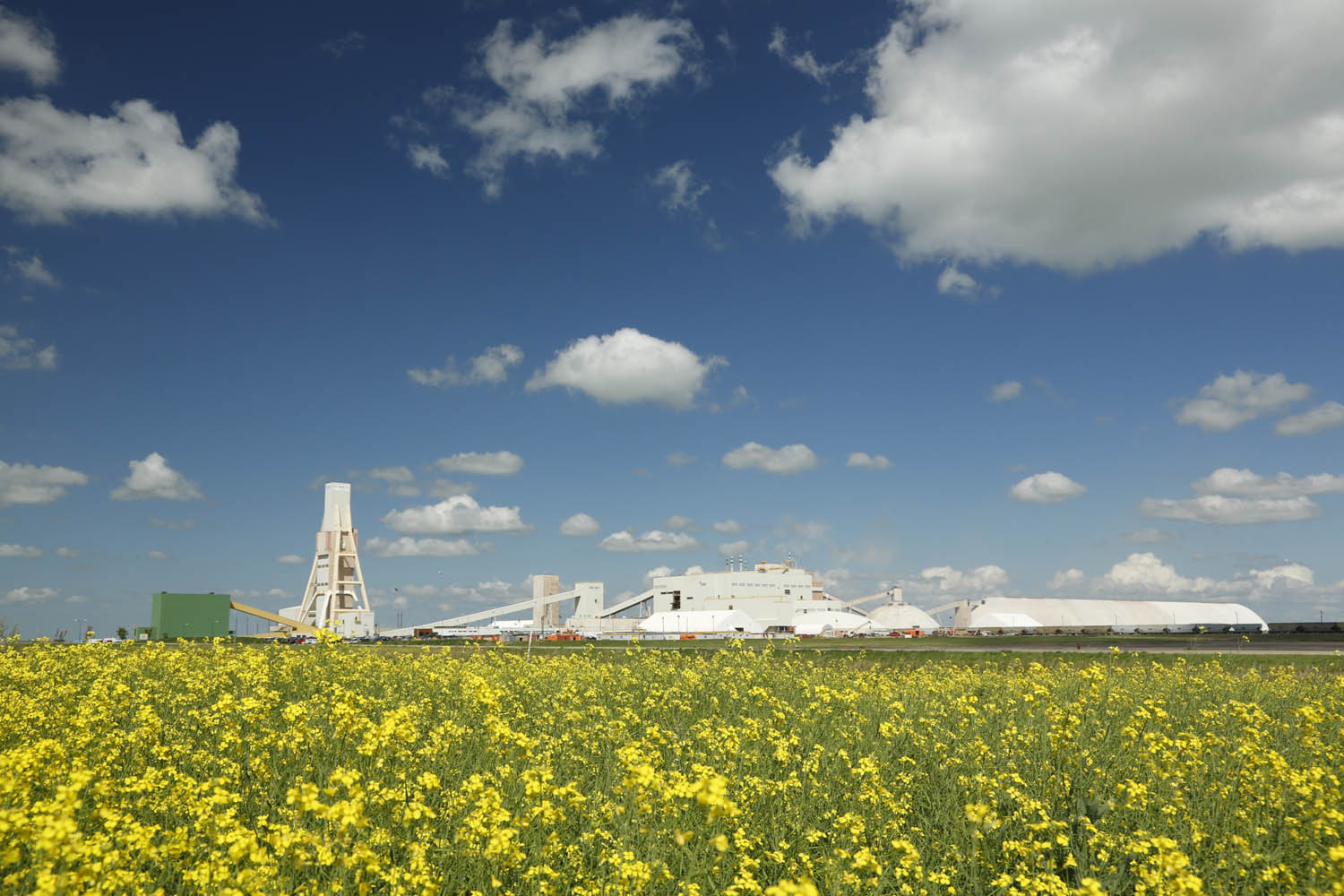
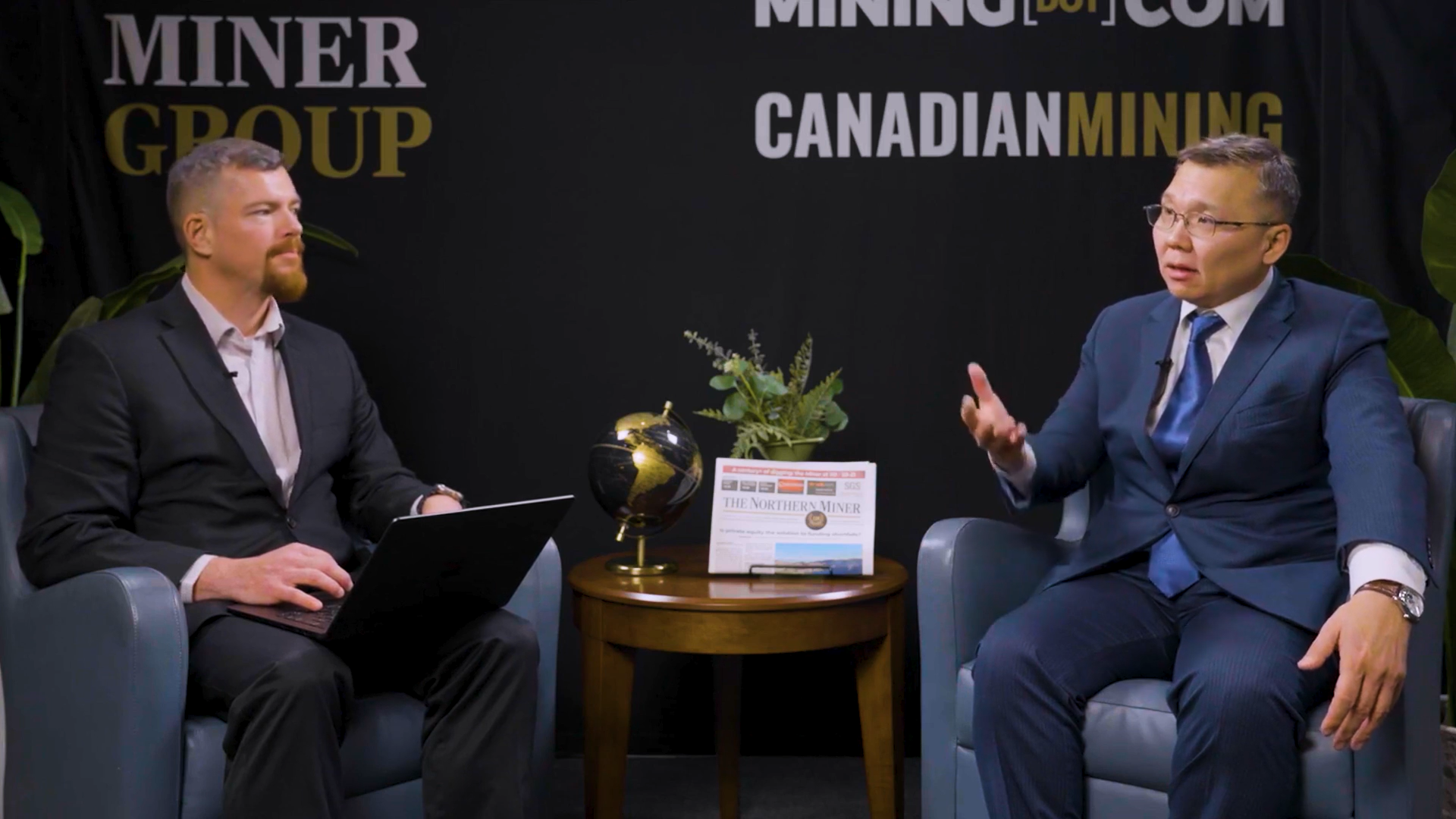
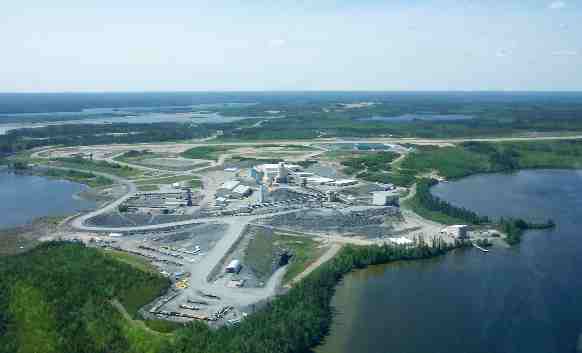
Comments